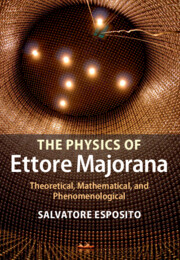Book contents
- Frontmatter
- Contents
- Acknowledgments
- Part I Introducing the character
- Part II Atomic physics
- Part III Nuclear and statistical physics
- Part IV Relativistic fields and group theory
- 7 Groups and their applications to quantum mechanics
- 8 Dirac equations and some alternatives
- Part V Quantum field theory
- Part VI Fundamental theories and other topics
- Part VII Beyond Majorana
- Appendix Molecular bonding in quantum mechanics
- References
- Author index
- Subject index
7 - Groups and their applications to quantum mechanics
Published online by Cambridge University Press: 18 December 2014
- Frontmatter
- Contents
- Acknowledgments
- Part I Introducing the character
- Part II Atomic physics
- Part III Nuclear and statistical physics
- Part IV Relativistic fields and group theory
- 7 Groups and their applications to quantum mechanics
- 8 Dirac equations and some alternatives
- Part V Quantum field theory
- Part VI Fundamental theories and other topics
- Part VII Beyond Majorana
- Appendix Molecular bonding in quantum mechanics
- References
- Author index
- Subject index
Summary
Among the very few books owned by Majorana (fewer than 30 volumes) we find Weyl's Gruppentheorie und Quantenmechanik in its first German edition (1928) [16]. Indeed, as we have already recalled, the clear group-theoretical approach pioneered by Weyl greatly influenced the scientific thought and work of Majorana. Group theory was revealed to be the appropriate mathematical framework for treating symmetries in quantum mechanics, as established in the books by Weyl [16], Wigner [263], and van der Waerden [264], but, despite its recognized relevance, the group-theoretical description of quantum mechanics in terms of symmetries was ignored by almost all theoretical physicists of the time (see Section 7.1), and only in recent times has it been included in physics textbooks. As a matter of fact, although almost every physicist had a copy of Weyl's book in the 1950s, the extensive use of group theory in physics research started, during those years, only in nuclear and particle physics.
Remarkably, such indifference did not apply at all to Majorana: the brilliant works on group theory and its applications of that mathematician, as well as those of Wigner, left an unambiguous and fruitful impression on the work of our author. Although this impression is recognizable on any technical page of the present book, in this chapter we will discuss in some detail several studies performed by Majorana on this subject, ranging from exquisitely mathematical results to genuinely physical applications, as was customary for him. Most of these results are not original, as Majorana reproduced what had been obtained by others (mainly by Weyl), but it is nevertheless interesting to see how Majorana obtained those results, and how he used group theory in order to obtain new physical results. As explained in Ref. [265], Majorana can be considered a faithful follower (probably, the only follower) of Weyl's thinking who went well beyond the path taken by Weyl himself, the main difference being in the approach adopted: mathematical for Weyl, physical for Majorana.
- Type
- Chapter
- Information
- The Physics of Ettore MajoranaTheoretical, Mathematical, and Phenomenological, pp. 149 - 174Publisher: Cambridge University PressPrint publication year: 2014



